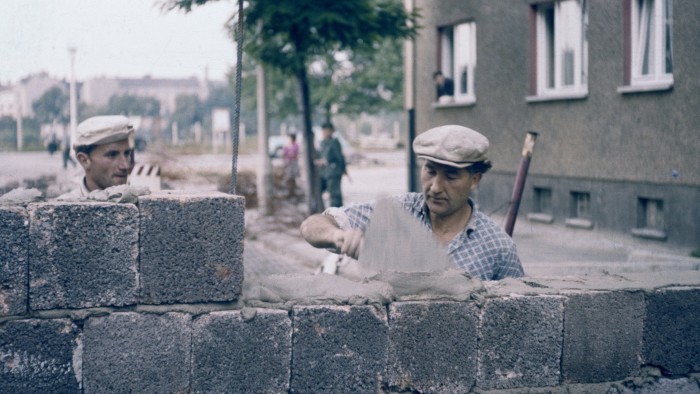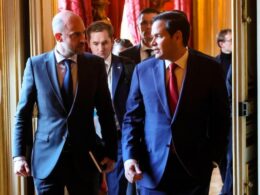Ten years ago, a book about the cold war would, in the words of historian Vladislav Zubok, have been a record of “dangerous but ancient times”. Today, with the US again locked in rivalry with Russia and China, and phrases such as “sphere of influence” and “proxy war” back in common use, it is actually the three-decade holiday from great power confrontation that followed the 1989 fall of the Berlin Wall that now seems to be the anomaly in need of an explanation.
The Cold War, Zubok’s monumental and still highly readable history of the US-USSR confrontation period, explores how that conflict not only shaped the post-1945 world but also the parallels with the “new world disorder” emerging today.
Much of the ground — the flashpoints from Berlin to Cuba to Vietnam — may have been well covered. But the interpretations — particularly how the cold war began and how it ended — are still being pursued by rival camps of experts. And, by smartly knitting together the past with the present, Zubok’s book brings a prescient and fresh perspective.
An émigré historian who teaches at the London School of Economics, Zubok witnessed the cold war from the Soviet side and sprinkles the book with personal anecdotes — such as the time he was reported to the KGB by a teacher for a school presentation on the US. Seeing the conflict from both sides is the strength of the book; Zubok pays attention to the unresolved faultlines of cold war scholarship and their ideological implications in the present day.
Was the descent into confrontation following the Grand Alliance of the second world war an avoidable result of US paranoia? Or would Stalin, if left unchallenged, have rolled Soviet ideology throughout Europe? The answer may be relevant to the furious debate today over China.
Historians such as William Appleman Williams have argued that the US exaggerated the threat of communism, and Stalin sought a balance in Europe, rather than domination. The opposing camp, led by John Lewis Gaddis and others, have argued that Stalin’s intentions were never about balance: his goal was rather “to dominate that continent as thoroughly as Hitler had sought to”, Gaddis wrote in his 2005 book The Cold War: A New History.
Zubok lands in the former camp, arguing that those who claim America had to act to save Europe from Stalin have overstated the threat he posed. The postwar USSR was weak and hungry, and Europe, despite the efforts of strong communist parties in France and Italy, had little interest in communism.
“I side with those who claim that the Cold War was caused by the American decision to build and maintain a global liberal order, not by the Soviet Union’s plans to spread communism in Europe,” he writes.
In other words, it was Washington’s messianism, not Moscow’s, that turned the tide towards mutual paranoia. The US — not unreasonably — considered that a world order based on balance between empires had failed the continent and resulted in the second world war. Washington wanted to replace a European system of balance of power and spheres of influence with an effort to allow Europeans to freely choose their destiny, including eastern Europe. Moscow saw this as a subversive effort to revise the 1945 Treaty of Yalta and grab their hard-won zone of influence. The Berlin blockade brought the conflict into the open and cast the Soviets as the villain.
Like some recent revisions to cold war history, notably Sergey Radchenko in his book To Run the World, Zubok downplays the role of ideology in the struggle between east and west, instead focusing on the international system of great power politics as the crux of the conflict. “The spectre of Mars, not Marx, led to the division of Europe into east and west,” as Zubok puts it. In other words, Russia sought (and is still seeking, most would argue) a world order in which the interests of great powers were recognised and took precedence over the aspirations of lesser nations.
This had been epitomised by the 1945 Yalta conference, during which Stalin, Churchill and Roosevelt split Europe into zones, feeding the Soviets’ coveted recognition of their equal status. “Stalin and his successors valued the ‘Yalta order’ enormously and considered it the bedrock achievement that made the Soviet Union a recognised world power,” Zubok writes.
“For the rest of the Cold War, every successive Kremlin leader would strive to reach this benchmark again and again, each time coming up against their main detractor, the United States.”
The thawing of the cold war began with Richard Nixon’s path-breaking 1972 trip to China, where Zubok concentrates, counter-intuitively but interestingly, on the effect this had on Brezhnev, who feared being outflanked in the east and launched an ultimately shortlived détente with the US president. As Zubok writes, Henry Kissinger, Nixon’s national security adviser, “used his opening to China to affect Soviet behaviour, yet he also managed Soviet fears and employed a backchannel to the Kremlin for constructive negotiations.”
Zubok also shows how the Soviets’ obsession with grand bargains, aimed at cementing their status, led to a conspicuous own goal: the 1975 Helsinki summit, which Soviet foreign minister Andrei Gromyko saw as akin to the Congress of Vienna and new “Concert of Europe”, a system of great power relations that defined much of the 19th century. Zubok shows how the Helsinki Final Act’s focus on human rights instead became a new genie of US diplomacy.
“We know today that Brezhnev’s ambition to have a ‘Concert of Europe’ backfired, and his belief in a bilateral partnership with Washington proved elusive,” Zubok writes. “The Final Act became indeed the foundational text of a new Europe, yet not what the Soviets had hoped to see. Human rights, enshrined in the document, became a scripture of internationalist liberalism.”
The overall effect of Zubok’s account is to realise how much of the spontaneity and contingency that we once thought drove human affairs in this period was actually hammered out by foreign policy bureaucrats in saunas, hunting lodges and back rooms. Was the “people power” witnessed in eastern Europe in 1989 ultimately the result of this US-Soviet bargain?
The end of the cold war is just as much of a Rorschach test as the beginning, writes Zubok, inviting the rival camps of experts to see whatever they wanted. Western triumphalists argue that America’s resolve and pressure won an inevitable victory; their opponents see Moscow as the main agent of its own fate.
“Historians can endlessly argue about what came first, the economic and Cold War pressures that pushed [Mikhail] Gorbachev and his circle of reformers to dismantle the old Soviet system, or the idea of a revolution that led to the weakening of the Soviet Union,” Zubok writes. “My own view is the latter but it is impossible to convince those who believe in the former.”
But one thing is “obvious”, he concludes: “the main engine for the multiple endings of the Cold War was in the Kremlin.”
The World of the Cold War: 1945-1991 by Vladislav Zubok, Pelican £25, 544 pages
Charles Clover is FT’s security & defence correspondent and a former Moscow bureau chief
Join our online book group on Facebook at FT Books Café and follow FT Weekend on Instagram and X









